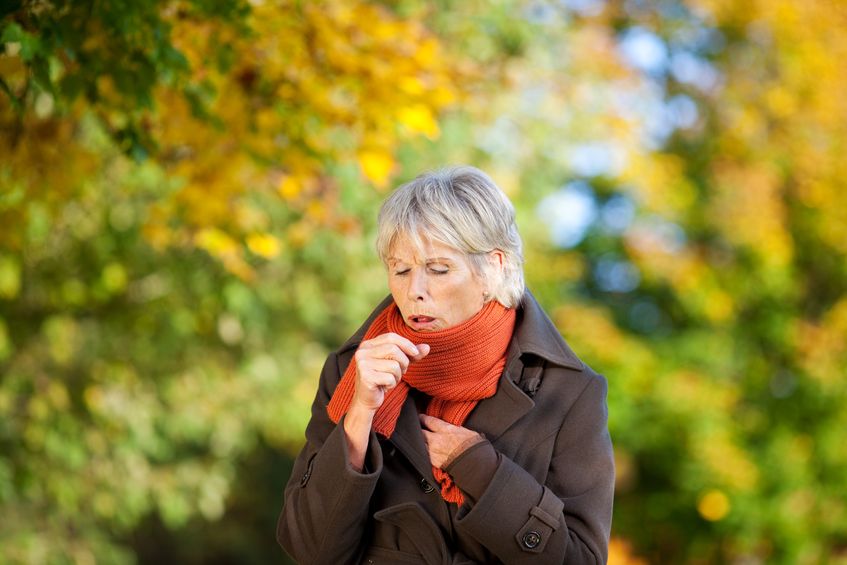Bronchitis is an acute inflammatory condition of the upper respiratory tract which is quite often preceded by a cold or flu. When the cold or influenza has evolved into bronchitis, it is often associated with giving antibiotics, anti-inflammatory agents and cough suppressants which do not allow the proper healing reaction to take place. Bronchitis by itself without a previous upper respiratory infection is rare. Malnutrition and exposure to environmental pollutants such as cigarette smoke or other air pollutants are also predisposing factors.
Initially the person may complain of low energy, chills, a low-grade fever, increased mucus discharge from the nose and throat, sore throat and chest and back pain or soreness. The onset of a cough usually is the initial sign of an impending bronchitis which may become more productive as the condition gets worse. Shortness of breath, wheezing and difficulty with breathing may also occur.
The condition is usually self-limiting but without proper treatment may become chronic and appear similar to emphysema. Any change in the person’s condition resulting in a greater difficulty with breathing should be referred to a physician as pneumonia can follow in chronic cases.
What to do until the doctor is seen
- Look for signs of airway obstruction or difficulty breathing. These may range from an irregular breathing pattern, to fits of coughing, or gasping for air.
- Make the person comfortable and take a pulse, respiration and temperature. Record for future reference.
- Choose any of the home therapies outlined and begin treatment. Any number can be used at the same time.
- If the patient is bringing up some phlegm, note its color and consistency, as this will help the physician to determine the stage of the disease.
- Contact your physician if the patient does not seem to be responding to the therapy or begins to get worse.
Case Management Suggestions
Even in younger, healthier patients, it takes longer to recover from bronchitis because of the poor blood supply to this area of the lungs. Therefore, do not change the remedy if the patient is making slow progress, as this may be a normal progression.
A return of the condition is frequently seen, as the patient will often stop therapy before the healing process has completed itself. Keep them on the medicine for an additional 7 to 10 days after symptoms have improved to avoid a relapse.
Elderly persons will take considerably longer to heal and need to be kept on the medicines for some time, even if they are responding well.
Homeopathic Medicines such as Aconite, Arsenicum album, Antimonium tartaricum, Belladonna, Bryonia, Freeun phosphoricum, Hepar Sulphuris, Phosphorus, and Spongia are often useful when treating bronchitis. Consider the “croup” triad of Aconite, Hepar sulph, and Spongia as these remedies are frequently seen in infants and small children.
Hydrotherapy using a variety of treatments such as the wet t-shirt, heating packs, steam inhalation, alternating hot and cold showers (being sure to end in cold) and humidifier are helpful.
Diet & Nutrition Remove all dairy products as these increase mucus production. Drink lots of fluids while increasing soups, salads, fruits and vegetables in the diet (alkaline diet). Garlic at 1 clove, chopped and swallowed with water 2 to 3 times per day in addition to Vitamin C at 3-5000 mg/day.
Herbal Medicines such as Coltsfoot, Garlic, Goldenseal, Grindelia, Sambucus, Horehound and Verbascum can be given.
This article is an excerpt from the Natural Medicine Pediatric Home Health Advisor
Thomas A. Kruzel N.D. is a naturopathic physician in private practice at the Rockwood Natural Medicine Clinic in Scottsdale, Arizona. He received a BA in Biology from the California State University at Northridge, and his Doctorate of Naturopathic Medicine degree from the National College of Naturopathic Medicine. Dr. Kruzel is also a board certified Medical Technologist. He completed 2 years of Family Practice Medicine residency at the Portland Naturopathic Clinic where he was chief resident prior to entering private practice. He also completed a fellowship in Geriatric Medicine through the Oregon Geriatric Education Center and the Portland VA Medical Center.
He has been an Associate Professor of Medicine at National College of Naturopathic Medicine where he has taught Clinical Laboratory Medicine, Geriatric Medicine and Clinical Urology. He is the author of the Homeopathic Emergency Guide A Quick Reference Handbook to Effective Homeopathic Care published by North Atlantic Books and Haug Publishers Germany, and has published numerous articles in The Journal of Naturopathic Medicine as well as other publications. He also is the author of the Natural Medicine Pediatric Home Health Advisor. He has been a member of the Alternative Medicine Review Editorial Review Board since 1997 and editor of the Clinical Medicine section of the Foundations Medical Textbook. He is also the past president of the American Association of Naturopathic Physicians and was selected as Physician of the Year by the AANP in 2000 and Physician of the Year by the Arizona Naturopathic Medical Association in 2003.






